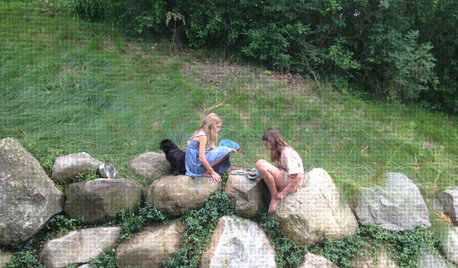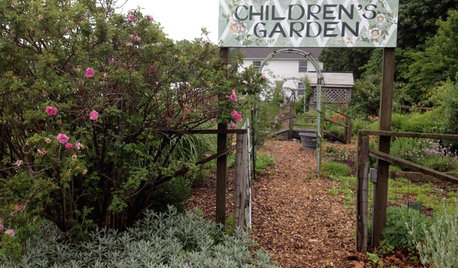How do I turn a weed field into a veggie garden?
mamala
14 years ago
Featured Answer
Sort by:Oldest
Comments (32)
gamebird
14 years agohatchjon
14 years agoRelated Discussions
weed question in veggie garden
Comments (4)I don't till my soil anymore but often still use newspaper to make the mulch material I have go further. Keep in mind the 3 major reasons to mulch, 1) Suppress unwanted (weed) growth, 2) aid in maintaining soil moisture, and 3) keeping the soil cooler and therefore more comfortable for the plants roots. So the question is not whether to mulch but with what and newspaper works quite well. Recycling to make more paper would be a good idea except there is such a glut of waste paper on the market that the price is way to low to make it worthwhile so recycling in the garden is a better use. But cover those papers with a mulch material rather than soil since "weeds" find it harder to grow in mulches than in soil....See MoreHow do I turn a driveway into a veggie garden?
Comments (8)Thanks for your responses! I was kind of thinking of going with slightly raised beds (not the ones that are completely above...just 6" - 1ft). The actual dirt there, *looks* pretty decent, just not much of it. :-) *My* garden spot, on the other hand, is mostly clay. Been working on that a little each year. I don't think she really had plans to be strictly organic. But, aside from the learning curve, don't think she'd be against it, either. I was thinking of removing several inches of the rocky stuff that is there, but, it seems like a lot of work (will have to do it by hand..shovel and wheelbarrow) and I got to wondering if it would be just fine with some compost thrown over / mixed in. I do have a 24" front tine tiller, but, no compost pile. That is something I was looking into over the Winter and going to try and get going this year. I don't have a lot of material myself, though. So, will have to scrounge for it to have enough to get a decent pile going. So, at this point, the plan would be to contain the area with landscape timbers/railroad ties, maybe 6-8" high, fill with compost (probably 1 pickup load for starters) and till it in. We may remove a couple of inches of the rock. Any other thoughts / ideas? Does this sound like a good plan? Thanks again!...See MoreHow do I grow field peas?
Comments (5)thanks. I'll check the link. The peas are really in the "bean" family. And yes they are susceptible to all kind of virus--for a couple of years, I'm certain I had V, F, as well as nematodes. --the leaves fell off from the bottom up, growth stunted--very susceptible to early blight. I found id I do get a few plant to make it to 6" tall and set blossoms, as soon as the blossoms are fertilized, it seems the curciol(sic) weevel hits them. Which ruins the pea, because it takes a long time to grow--longer than it takes the weevel to be full grown and have eaten all of the maturing peas. I was really disappointed when I saw that damage. If I spray (checmical) to kil the pea weevil, I wind up killing beas as well, which I don't want to do. The peas as you might have read, have a much more bean like flavor than anything you'd expect from a "pea." They are a wonderful flavor. When cooked, the water turns brown, as well as the pea. It looks like the only way to grow these is in a greenhouse or something like that? It's frustrating, but then I guess I'd have a difficult time growing sugar cane here, too. I did have success one year with the "Christmas" lima, pole bean--it gets its name from purple-red blotches on a white lima. The flavor is nothing like a green lima or those big, ugly white ones that you can get in a can. Thanks for taking the time to look things up. I tool looked and found that the U. of Minnesota is working with them. You'd think if they grow in Minnesota, they'd make it here. But as you said, it may be more the lack of humidity and differential between day/night temps. Is there any Master Gardner on here that would like to take a shot at this. --I did get okra to grow, once I found the right variety--now if I could just get the field peas going, too....See MoreField horsetail...how do I get rid of it?
Comments (3)If you're talking about Equisetum arvense, then a couple options might be to a) hoe them out, especially when the soil is moist. You must be careful not to snap the roots, getting under the base of the plant. Remove as many of the connected roots as possible, and put in the trash, not the compost bin (muy importante!). OR b) you can herbicide the heck out of them. Do you happen to know how they arrived in your yard? Brenda...See Moremarlingardener
14 years agomamala
14 years agoiam3killerbs
14 years agogardenmom2
14 years agoveggiefaery
14 years agogardenlen
14 years agoshawnann
14 years agojessicavanderhoff
14 years agogamebird
14 years agowayne_5 zone 6a Central Indiana
14 years agoflowersnow
14 years agoheather38
14 years agojonas302
14 years agosfallen2002
14 years agospiced_ham
14 years agomedcave
14 years agomamala
14 years agowayne_5 zone 6a Central Indiana
14 years agomamala
14 years agoglib
14 years agoDrHorticulture_
14 years agomadmantrapper
14 years agojnfr
14 years agomacky77
14 years agoglib
14 years agomamala
14 years agomamala
14 years agogardener_mary
14 years agomacky77
14 years ago
Related Stories

EDIBLE GARDENSNatural Ways to Get Rid of Weeds in Your Garden
Use these techniques to help prevent the spread of weeds and to learn about your soil
Full Story
GARDENING GUIDESLet's Weed Out 4 Native Plant Myths
Plant wisely for a garden that supports pollinators and requires less work
Full Story
HOUZZ TOURSHouzz Tour: From Overgrown Weeds to Picturesque Farmhouse Expanse
This once-neglected 100-acre South Carolina site now features a lake, a wood-filled farmhouse and a far-reaching view
Full Story
GARDENING GUIDES5 Weed-Smothering Ground Covers
Let these landscape plants do the dirty work of choking out weeds while you sit back and enjoy the view
Full Story
GARDENING GUIDESGreat Design Plant: Bugle Weed, a Quick Ground Cover
It’s highly adaptable, suppresses weeds, reduces erosion and provide weeks of bright flowers. Just watch for invasiveness
Full Story
GARDENING GUIDES5 Ways to Naturally Win the Weed War
Show irksome weeds no mercy with these tricks for combating them sans chemicals
Full Story
GARDENING GUIDESTackle Weeds the Natural Way
Instead of dousing your yard with chemicals to wipe out weeds, let time and nature work their magic via smothering and solarization
Full Story
GARDENING GUIDESWeed War: When and How to Use Chemical Herbicides
Before you spray, arm yourself with knowledge about which weed killers — natural or synthetic — are right for your yard
Full Story
LIFETurn Off the Video Games and Turn On Your Kid's Creativity
Going nuts planning summer activities? Kids overdosing on screen time? It may be time to foster more self-directed play
Full Story
GARDENING GUIDESField Trip: Gather Ideas on a DIY Garden Tour
Get inspired by one gardener's local tour, then check out her suggestions for unofficial tours of your own
Full Story


anney